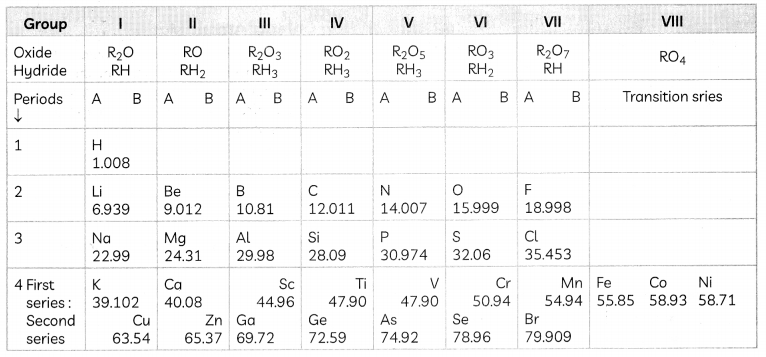Mendeleev’s Periodic Table
The main credit for classifying elements goes to Dmitri Ivanovich Mendeleev, a Russian chemist. He was the most important contributor to the early development of a Periodic Table of elements wherein the elements were arranged on the basis of their fundamental property, the atomic mass, and also on the similarity of chemical properties.
- When Mendeleev started his work, 63 elements were known.
- He examined the relationship between the atomic masses of the elements and their physical and chemical properties.
- Among chemical properties, Mendeleev concentrated on the compounds formed by elements with oxygen and hydrogen.
- He selected hydrogen and oxygen as they are very reactive and formed compounds with most elements, me formulae of the hydrides and oxides formed by an element were treated as one of the basic properties of an element for its classification.
- He then took 63 cards and on each card he wrote down the properties of one element.
- He sorted out the elements with similar properties and pinned the cards together on a wall.
- He observed that most of the elements got a place in a Periodic Table and were arranged in the order of their increasing atomic masses.
- It was also observed that there occurs a periodic recurrence of elements with similar physical and chemical properties.
Mendeleev Periodic Law: ‘The properties of elements are the periodic function of their atomic masses’.


Features of Mendeleev’s Periodic Table
- Mendeleev’s Periodic Table contains verticaL columns called ‘groups’ and horizontal rows called ‘periods’.
- This table contains 8 groups and 6 periods.
- The formula for oxides and hydrides are written at the top of the columns of Mendeleev’s periodic table, where the letter ‘R’ is used to represent any of the elements in the group. For example, the hydride of carbon, CH4, is written as RH4, and the oxide CO2, as RO2.
Achievements of Mendeleev’s Periodic Table
1. Mendeleev’s periodic law predicted the existence of some elements that had not been discovered at that time. Mendeleev Left some gaps in his Periodic Table. Mendeleev named them by prefixing a Sanskrit numeral, Eka (one) to the name of preceding element in the same group.
For example: Scandium, gallium and germanium, discovered later, have properties similar to Eka-boron, Eka-aluminium and Eka-silicon, respectively.
The properties of Eka-Aluminium predicted by Mendeleev and those of the element, gallium which was discovered later and replaced Eka aluminum, are listed as follows.

2. Mendeleev’s periodic table could predict the properties of several elements on the basis of their positions ¡ri the periodic table.
3. It could accommodate nobte gases when these gases were discovered in a new group without disturbing the existing order.
Limitations of Mendeleev’s Classification
Position of Hydrogen
The electronic configuration of hydrogen resembles that of alkaLi metals. Like alkali metals, hydrogen combines with halogens, oxygen, and sulfur to form compounds having similar formulae. On the other hand, just like halogens, hydrogen also exists as diatomic molecules and it combines with metals and non-metals to form covalent compounds.
Thus, a correct position couLd not be assigned to hydrogen in the periodic table.
Position of Isotopes
The position of isotopes could not be explained since the elements are arranged according to their atomic masses and isotopes are atoms of the same element having similar chemical properties but different atomic masses.
| Compounds of H | Compounds of Na |
| HCl | NaCl |
| H2O | Na2S |
| H2S | Na2S |
The position of isotopes, which were discovered much later, could not be explained as they were placed in the same group.
Wrong Order of Atomic Masses
There were a few instances where Mendeleev had to place an element with a slightly greater atomic mass before an element with a slightly lower atomic mass. The sequence was inverted so that elements with similar properties could be grouped together.
For example, cobalt (atomic mass 58.9) appeared before nickel (atomic mass 58.7).
The wrong order of atomic masses of some elements could not be explained.
Non-uniform Variation of Atomic Masses
Another problem was that the atomic masses do not increase in a regular manner in going from one element to the next. So it was not possible to predict how many elements could be discovered between two elements especially when we consider the heavier elements.